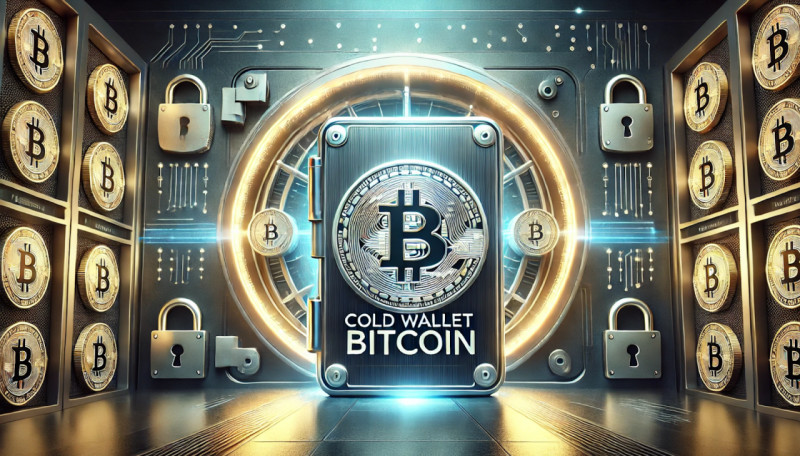
Managing digital wealth securely is crucial, especially when considering cold wallet Bitcoin as a trusted method for asset protection. A Bitcoin wallet operating offline provides strong defense against cyber threats, that attracts those prioritizing security as well as long-term safety in the evolving digital landscape.
Importance of Offline Solutions
Digital assets, such as Bitcoin, face many online risks. Offline systems, or cold storage, minimize exposure by being completely disconnected from the internet.
Key threats addressed by offline solutions:
- Hacking & phishing: staying unconnected keeps sensitive data out of cybercriminals’ reach.
- Malware: viruses along with malicious software are ineffective in unconnected environments.
- Unauthorized access: only the rightful owner can access assets, as offline methods prevent remote entry.
Offline instruments reduce these risks, offering unparalleled security compared to online alternatives.
Benefits of Offline Wallet Systems
Enhanced security: disconnecting from the internet shields private keys from hackers, reducing the risk of unauthorized access, phishing attacks.
Complete ownership: users maintain full control over their funds, without relying on third-party platforms. This aligns with Bitcoin's decentralized nature, where individuals manage their holdings independently.
Long-term asset protection: offline storage suits those holding large amounts or seeking long-term safety. Physical wallet minimizes accidental loss, safeguarding assets from hacks or device failures.
Privacy & anonymity: unconnected systems protect personal data as well as transaction history, reducing exposure, enhancing confidentiality. This helps keep financial activities private.
How Cold Storage Systems Operate
Offline solutions work by isolating the access credentials necessary to manage Bitcoin holdings.
Key components:
- Private keys: these credentials are required to access digital funds. Keeping them secret is essential to prevent unauthorized use.
- Public keys: required for receiving funds, these can be shared openly without compromising security.
- Blockchain integration: though unconnected, transactions are recorded on the blockchain when the system reconnects.
The primary goal is ensuring private keys remain unreachable by online threats, protecting both ownership and usability.
Types of Cold Wallet Solutions
Offline storage methods vary, letting users choose the best solution that suits their needs:
Hardware devices: instruments like Ledger or Trezor securely keep keys offline. These devices require physical access, adding an extra layer of protection.
Paper keys: printed access credentials kept in a secure location. This simple yet effective method provides offline protection.
Air-gapped systems: isolated computers or devices used solely to manage credentials, offering maximum security but at the cost of convenience.
Why Cold Storage Matters
As the digital economy grows, so does the secure asset management need. Offline storage ensures protection from constant online dangers. Whether securing significant sums or prioritizing privacy, unconnected solutions meet the requests of those seeking both safety and independence.
By choosing offline wallet solutions, users can confidently navigate the digital landscape. With the right instruments, the risks associated with online asset management are significantly reduced, letting individuals focus on growth along with new opportunities.
What Is Offline Storage?
A cold wallet bitcoin is an offline solution designed to secure digital assets. Unlike hot storages that stay connected online, unconnected wallets prioritize protection by staying completely disconnected from the internet. This prevents private keys — critical credentials for accessing funds — from being exposed to online threats such as hacking, malware, or phishing.
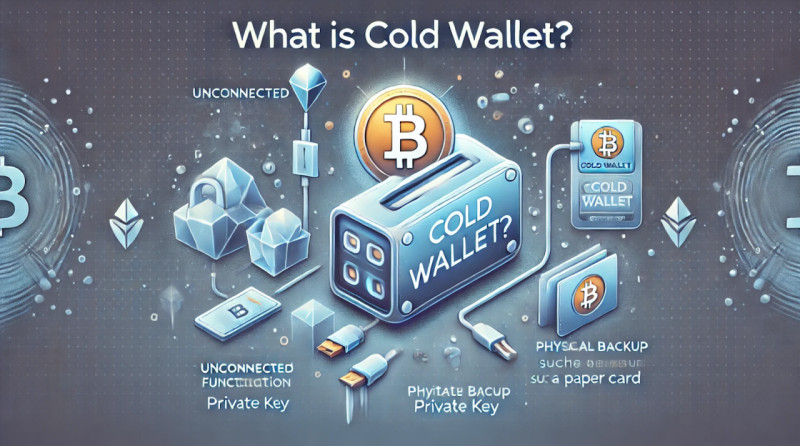
Definition and Purpose
Offline wallets offer secure environments for managing Bitcoin, protecting assets from unauthorized access. The key difference from hot wallets is their offline nature. By avoiding internet connections, unconnected storages eliminate many risks linked to online platforms, including cyberattacks as well as data breaches. These solutions are preferred by users seeking long-term asset protection, particularly investors or holders who don't need constant access.
Key Features:
- Unconnected functionality: cold wallets never have internet connection, protecting them from digital vulnerabilities that affect online systems. As a result, private keys along with transaction data remain safe from hackers or malicious actors, offering enhanced security.
- Private key protection: since private keys allow access to funds, unconnected storages keep them offline, preventing cybercriminals from stealing or compromising them. With no online interaction, these keys are protected from remote hacking attempts targeting online storage.
- Physical backup: offline wallets often feature physical backup methods, such as hardware devices, paper wallets, or metal plates with recovery phrases. These tangible backups offer extra protection against loss, accidental deletion, or damage — risks present in digital-only storage solutions. In particular, even if a hardware device is lost or damaged, a paper or metal backup ensures users can still recover their funds.
Offline storage serves as a secure, unconnected vault for Bitcoin, safeguarding assets from online threats. This method is regarded as one of the most reliable ways to protect digital wealth, especially preferred by those holding significant amounts or planning long-term storage.
How Offline Solutions Differ from Hot Wallets
Both cold and hot wallets serve to manage Bitcoin, but they differ notably in terms of security, accessibility, intended use. The primary distinction is whether or not the storage has an internet connection.
| Feature | Cold Wallet | Hot Wallet |
| Internet connection | No | Yes |
| Security level | High | Moderate |
| Accessibility | Less convenient (requires physical access) | Highly convenient (online access) |
| Best for | Long-term savings | Daily transactions |
Internet Connection
The main difference lies in internet access. Offline wallets don’t have internet connection, making them far less vulnerable to online attacks. Hot wallets, conversely, rely on constant internet connectivity, exposing them to risks such as hacking, phishing, malware.
Security Level
Offline storage offers superior security because of its unconnected status. Funds kept in an offline storage cannot be accessed remotely unless someone physically controls the backup device. Hot solutions, while secure, remain exposed to various digital threats because of their online nature.
Accessibility
Offline storages require physical access to the device or backup, making them less convenient for frequent use. In particular, a hardware device needs connection to a computer and a PIN entered for access. Hot wallets, however, provide quick access to funds from any connected device, which makes them preferred by users who need regular access to realize transactions.
Best For
Cold wallet Bitcoin suits long-term holders who don't need constant access to funds. They offer peace of mind, top-tier security for those prioritizing safety over convenience. Hot wallets are preferred by individuals who require fast access in order to execute daily trading or spending.
Conclusion
Both cold and hot wallets have essential roles in the Bitcoin ecosystem, but unconnected storage is often preferred by those focused on long-term security. Cold wallet provides unmatched protection of assets, making it the preferred method for serious investors or those holding substantial Bitcoin. Though less convenient than hot wallets, the added security of offline storage is often well worth the trade-off.
Why Choose Cold Wallets?
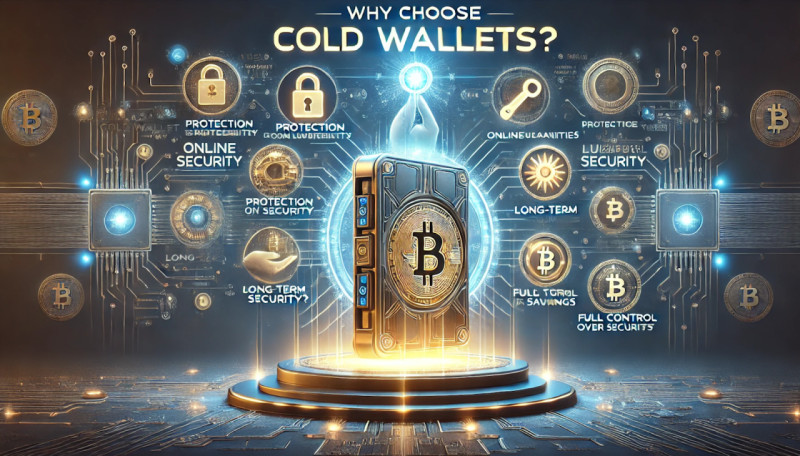
Enhanced Security
Unconnected wallets provide superior protection by keeping private keys unconnected, isolating critical credentials from cyber threats such as hacking, malware, phishing. Online platforms are often targeted by malicious actors, but offline solutions safeguard sensitive data. Malware targeting connected devices is ineffective against cold storages. Moreover, unconnected storage prevents exposure in case of breaches at exchanges or within online services.
This unmatched security especially suits large investments. With no connection to online systems, the likelihood of unauthorized access is minimized, letting users protect their wealth in a digital world. By choosing cold storage, Bitcoin holders significantly reduce the risk of hacking or scams, creating a safer environment for digital assets.
Ideal for Long-Term Savings
Offline wallets excel at protecting assets over extended periods, making them preferred by Bitcoin holders who do not need regular access. Holding Bitcoin unconnected assures that assets remain safe from daily digital threats. Cold storages offer a secure, stable solution, allowing long-term growth or savings of digital assets.
This method suits individuals who prefer long-term holding of Bitcoin, eliminating risks linked to digital wallets accessed frequently. By minimizing online exposure, unconnected storage ensures safer, simpler long-term protection. Users no longer need to worry about breaches or compromises common in internet-connected platforms.
Protection from Online Vulnerabilities
The primary advantage of offline storages lies in their unconnected nature. These solutions avoid the risks tied to connected devices or services, such as data breaches, hacking, malware — issues frequently seen in exchanges, apps, digital platforms. By keeping private keys offline, they cannot be intercepted or stolen.
Third-party platforms like exchanges or online wallets are often targeted by hackers. With more data kept online, the risk of breaches grows. Unconnected wallets eliminate these risks by keeping keys offline, giving Bitcoin holders full control and keeping wealth secure, private, shielded from external threats.
Benefits of Offline Solutions
Full Control Over Access
Unconnected systems give users exclusive control of their assets, requiring physical access to backup devices or keys. No online service can match this level of control, making cold storages a highly secure choice. This aligns with Bitcoin's decentralized nature, letting individuals own their funds without relying on potentially vulnerable third-party services.
Unconnected storage guarantees that even if a third-party service is compromised, assets remain safe. Accessing Bitcoin depends solely on physical security, making unauthorized control difficult. Cold wallet Bitcoin empowers users with complete ownership, eliminating reliance on external platforms.
Resilience Against Failures
Online services are susceptible to outages, crashes, or technical glitches, preventing users from accessing their funds. Offline wallets, however, are independent of these risks. They do not rely on servers or online systems, ensuring access even during system failures. If a device malfunctions or software issues arise, funds remain secure as long as recovery phrases or backup devices are properly kept.
By contrast, online solutions may become inaccessible during exchange downtime, hacks, or server issues. Unconnected storage removes this vulnerability, providing users with offline access to their funds at any time, free from digital threats or reliance on third-party providers.
Secure High-Value Holdings
Cold storages offer unparalleled protection for Bitcoin holders managing large amounts. With added layers of security, such as hardware devices or paper-based keys, offline storage significantly reduces the chance of losing access because of hacking or fraud. Cold wallets provide peace of mind, ensuring that even if an exchange is compromised or a malware attack occurs, funds remain secure.
Those who keep high-value holdings face the increasing risks associated with online wallets, as larger sums attract more attention from malicious actors. Unconnected storages reduce this risk by keeping assets offline as well as protected by physical security.
When to Use Cold Wallets
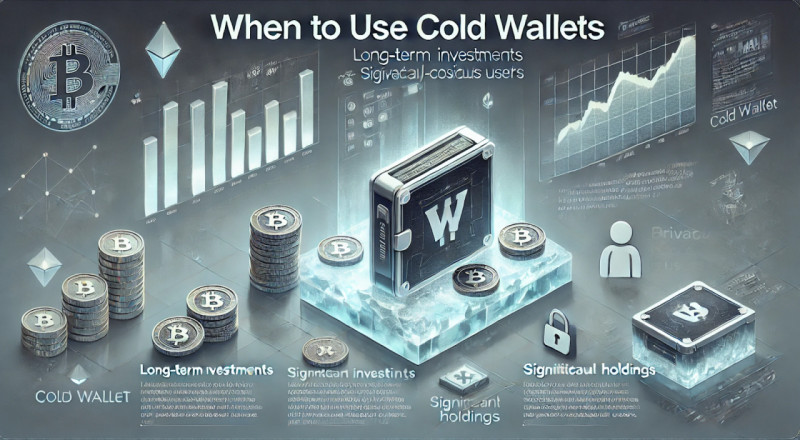
Long-Term Investments
Cold storage is preferred by those planning to hold Bitcoin over several years. Since unconnected wallets are offline, they remove the risks associated with frequent online access. This method ensures assets stay secure over time, whether waiting for a price increase or simply keeping Bitcoin as a savings asset. Once placed in offline storage, Bitcoin remains protected from digital threats until the user decides to sell or trade.
Significant Holdings
Cold storage is often preferred by those who manage large Bitcoin holdings. By keeping funds offline, users prevent loss through hacking, scams, or vulnerabilities in online platforms. Exchanges or hot wallets are prime targets because of the volume of wealth they manage, but unconnected storages offer added protection by isolating assets from digital threats.
Privacy-Conscious Users
Cold wallets are helpful to those who prioritize privacy. Since assets remain offline, no digital trace is left for tracking back to the user. This is crucial for individuals who have a need in keeping financial activities private or avoid exposing sensitive transaction details.
Using unconnected storage ensures high levels of confidentiality. With no transaction history or personal data kept online, Bitcoin holders preserve anonymity as well as protect their privacy.
Conclusion
A cold storage solution is often chosen by anyone serious about securing assets in an increasingly connected world. It provides unmatched protection, enabling individuals to safeguard funds long-term while maintaining full control. Whether holding for future growth or prioritizing security, unconnected wallet remains one of the most reliable ways to protect digital wealth at the moment.
Types of Cold Wallets
Securing Bitcoin offline involves a variety of methods, each offering different levels of security, convenience, complexity. Below are common cold storage options for safeguarding digital assets.
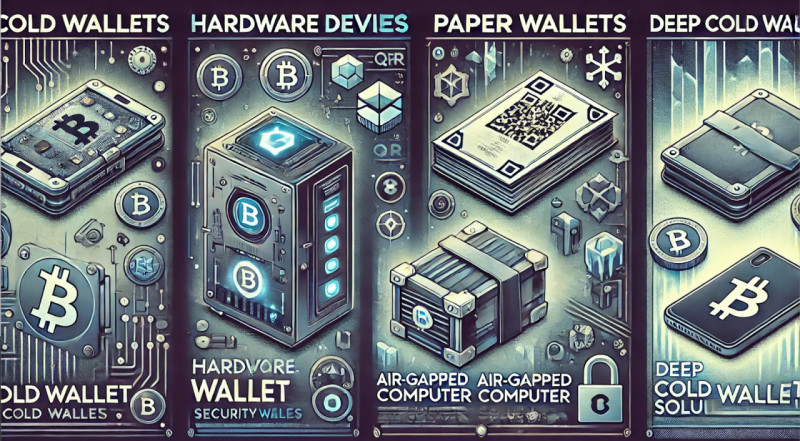
Hardware Devices
Cold wallet Bitcoin like Ledger, Trezor, Coldcard are commonly used to protect Bitcoin offline. These physical instruments encrypt private keys, ensuring they stay secure against online threats. Transactions require physical access, preventing keys from going online. These devices also feature PIN codes as well as recovery phrases in case access is lost or compromised.
Key features:
- Encrypted storage: private keys are kept securely offline, protecting against online threats.
- PIN protection: access requires a PIN, adding an extra security layer.
- Recovery phrases: lost or damaged devices can be restored with a 12-24 word recovery phrase.
| Pros | Cons |
| Highly secure: unconnected wallets make them resistant to hacking, malware | Cost: priced between $50-$200, depending on the model |
| Convenient long-term storage: secure yet accessible when necessary | Physical vulnerability: loss or damage requires secure storage of the recovery phrase |
| Portable: compact devices are easy to carry | Setup complexity: some users find setup intimidating but manageable with research |
Paper Wallets
Paper wallets are printed documents with private and public keys, usually in QR code format. Generated offline, these wallets offer secure Bitcoin storage fully disconnected from the internet.
| Benefits | Risks |
| Offline security: paper wallets avoid online attacks like hacking or phishing | Physical damage: vulnerable to water, fire, or wear, which can render them unusable |
| Cost-effective: creation is free, needing only a printer, secure unconnected computer | Loss of paper: if lost, stolen, or damaged, recovery is only possible with the backup phrase |
| Portable: easy to carry or keep securely |
How to create and store securely:
- Generate offline: create paper wallets on an unconnected computer for minimization of malware risks.
- Use a secure printer: ensure a trusted unconnected printer is used.
- Store safely: keep the paper wallet in a fireproof, waterproof safe, which can be accessed only by trusted individuals.
Air-Gapped Computers
An air-gapped computer is fully disconnected from any network. Used to generate, keep, manage private keys, it provides maximum security by remaining offline, protected from online threats like malware or hackers.
Setting up for maximum security
- Dedicated device: use a computer exclusively for cryptocurrency management, never connect it to the internet.
- Generate keys offline: generate private keys offline, then use a USB drive to transfer signed transactions for broadcasting them.
- Regular maintenance: keep the system minimal, using only trusted software. Periodically wipe the system, reinstall essential programs.
| Pros | Cons |
| Ultimate security: air-gapped systems offer premier protection by staying offline | Complex setup: requires technical knowledge, which makes its usage hard for beginners |
| Full control: users manage private keys without relying on third-party services | Inconvenience: accessing funds isn’t as easy as using an online wallet. Transactions should be signed offline, transferred via USB for broadcasting |
| Customizable: tailor the setup to specific security needs | No instant access: peferred by those who need long-term storage, but not suited for frequent transactions |
Deep Cold Wallet Solutions
For institutional holders or those with substantial holdings, deep cold wallet Bitcoin offers the highest level of protection. It combines hardware devices with physical security measures like vaults or safety deposit boxes to keep assets in ultra-secure, offsite locations.
Methods used:
- Safety deposit boxes: hardware devices or paper wallets are kept in a bank’s safety deposit box, offering protection from theft, fire, other risks.
- Vaults: specialized vaults provide high-level security for holding digital assets offline.
- Multi-signature solutions: this approach requires multiple keys, kept in different locations or by different parties, reducing the risk of collapse.
| Benefits | Cons |
| Maximum security: chosen by institutional investors or large holdings, combining physical along with cyber protection | Expensive: high security comes at a premium |
| Insurance: many deep storage services offer insurance coverage, providing peace of mind against theft, loss, or disasters | Complex management: coordinating multiple locations, recovery processes, security measures requires careful attention, which makes it impractical to manage by casual users |
| Risk mitigation: assets are kept in multiple locations with multi-signature control, ensuring no single event (e.g., robbery, fire) results in breakdown |
Summary
Securing Bitcoin unconnected offers various methods, each adapted for specific needs. Whether using a hardware device, paper wallet, air-gapped computer, or advanced deep cold storage, the right choice depends on individual security requirements, holdings, technical expertise. An offline storage solution provides robust protection against online threats, ensuring users maintain control over assets, free from digital risks. Each option involves trade-offs in security, cost, convenience, making it crucial to assess personal needs ahead of selecting the most suitable method.
How to Create a Cold Storage
Creating a secure unconnected wallet solution requires careful planning. Whether choosing a hardware device, paper printout, or advanced air-gapped systems, the goal remains protecting private keys from online threats. Here’s a step-by-step guide to crafting an effective offline storage method, ensuring assets stay secure as well as accessible solely by you.
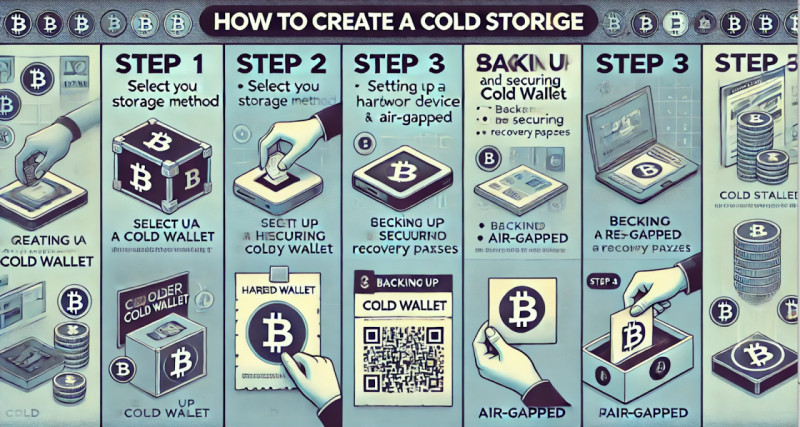
Step-by-Step Guide
Select a storage method. The right choice depends on components such as Bitcoin amount, technical ability, frequency of access. Common options include:
- Hardware devices: preferred by those seeking convenience, security, ease of access. Devices like Ledger, Trezor, Coldcard encrypt keys, require PINs, offer recovery phrases.
- Paper wallets: low-cost solution, paper wallets can be generated offline but require careful managing to avoid damage or loss.
- Air-gapped systems: suited for large holdings or advanced needs, these isolated computers keep keys offline, ensuring maximum security.
Each method has distinct advantages, so choose based on your specific needs along with expertise.
Setting up a hardware device requires following these steps:
- Install software: begin by downloading the official software to your device. This tool will let you configure the device as well as generate keys.
- Generate private keys: device will generate unique private keys, ensuring they remain unconnected as well as protected from online threats.
- Record the recovery phrase: device will provide a backup phrase (typically 12 or 24 words). Keep it in a secure location.
- Verify and test: confirm the keys along with recovery phrase are correct, ensuring no errors ahead of keeping them safely.
Creating a paper cold wallet Bitcoin requires taking these steps:
- Generate offline: use an unconnected computer to generate private and public keys. Websites like bitaddress.org allow secure key creation without an internet connection.
- Print the wallet: print both keys on durable paper. This printout will show the public address (to receive funds), the private key (to spend).
- Double check: verify QR codes are scannable, the private key is clear as well as legible.
Backing up, securing recovery phrases regardless of the storage method. Securing recovery data is critical:
- Secure storage: write recovery phrases down, keep them in multiple locations (safe, safety deposit box, or with trusted family members). Ensure these locations are separated for minimizing the risk of simultaneous damage or theft.
- Use durable materials: paper is vulnerable, so consider engraving recovery phrases on metal plates. These are more resistant to fire, water, general wear.
- Avoid digital copies: never keep recovery phrases on computers, phones, or cloud services, as they are susceptible to hacking.
Ensuring Security
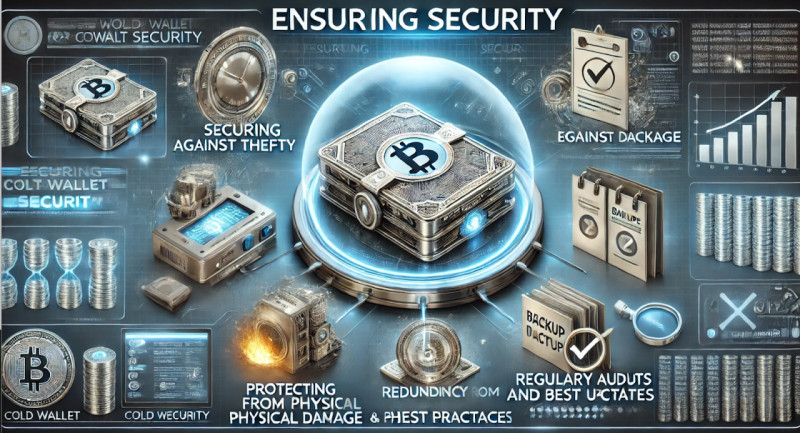
Protecting from physical damage. Unconnected storage, especially paper wallets, can be susceptible to damage. Consider these tips:
- Fireproof, waterproof containers: keep physical wallets in fireproof, waterproof safes or containers.
- Metal backup: engrave recovery phrases onto metal, which can withstand fire, water, general wear better than paper.
- Regular inspections: periodically check your wallet, ensuring no damage has occurred.
Securing against theft. Physical theft remains a risk, even with offline storage. Reduce the risk by:
- Multiple copies: keep backups in separate, secure locations (e.g., safes, safety deposit boxes, or trusted family members’ homes).
- Multi-location backup: for securing large holdings, consider using a combination of storage methods — part on a hardware device, the rest on paper or deep vault storage.
- Disguise and conceal: avoid obvious storage options like safes. Consider unconventional places or multi-party access (involving family or trusted partners).
Redundancy and best practices. Cold wallet benefits from redundancy. Best practices include:
- Multiple devices: for hardware devices, set up more than one device, keep each in a separate, secure location.
- Split keys: some users split private keys into parts, keep them separately, ensuring no one location holds full access.
- Multi-signature options: for securing large holdings, multi-signature setups require several keys to approve transactions, reducing risk if one key is compromised.
Regular audits, updates. Conduct regular checks on your unconnected storage setup:
- Update security protocols: ensure hardware devices have the latest firmware updates to fix any vulnerabilities.
- Test recovery procedures: periodically test recovery using backup data to ensure the process works as expected.
- Change locations or methods: if any storage method or location appears compromised, move assets to a more secure setup.
By following these steps, you can ensure that Bitcoin remains secure. Whether using a paper wallet or advanced hardware solution, always prioritize security, redundancy, caution. An offline storage solution shields assets from both online and physical threats, providing long-term protection.
Using Offline Wallet: Best Practices
Securing Bitcoin offline protects it from online threats, but managing a cold wallet bitcoin requires precision. This guide helps with managing Bitcoin in cold storage, ensuring secure transfers, easy access, long-term setup integrity.
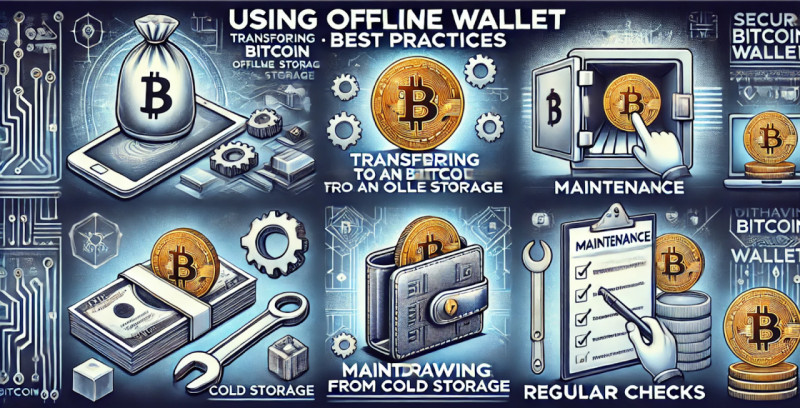
Transferring Bitcoin to an Offline Storage
Sending Bitcoin. Securely transferring Bitcoin is simple, but caution is essential:
- Prepare cold wallet: if using a hardware device, connect it, ensure software is updated. With paper wallets, verify the public key (Bitcoin address) is visible as well as correct.
- Double-check the address: address errors result in irreversible loss. Always verify the address by scanning the QR code or entering it manually. Cross-check with what’s shown on your storage device or paper printout.
- Secure connection: conduct transactions over a private, secure connection. Avoid public Wi-Fi for reducing exposure to potential hacks.
- Test with small amounts: ahead of transferring larger sums, try with a small amount to ensure everything works as expected.
Verifying transaction details. Double-checking prevents errors or scams:
- Confirm amount: ensure the amount matches your intent.
- Transaction fees: be aware that fees fluctuate depending on network congestion. Confirm the fee will ensure quick confirmation without exceeding what you're willing to pay.
- Key safety: share only public keys. Never expose private keys.
Withdrawing Bitcoin from Cold Storage
Accessing Bitcoin from an offline storage. When you need access, follow these steps:
- Connect hardware device: connect device to your computer, open the software, unlock with your PIN or passphrase.
- Import keys from paper wallet: if using a paper wallet, import the private key into a software or hardware device. You can do this by scanning the private key’s QR code or entering it manually.
- Initiate transaction: once access is granted, input the recipient’s address along with the transaction amount. Verify the details ahead of confirming.
Safely spending Bitcoin. After confirming a transaction, check its status using a blockchain explorer. Keep these tips in mind:
- Secure connection: ensure your device is malware-free, connected to a trusted network.
- Avoid sharing private keys: exposing private keys grants full reach of funds, heightening theft risk.
Maintenance, Regular Checks

Protecting recovery phrases. Recovery phrases are essential to regaining access. Safeguard them:
- Keep in multiple locations: write recovery phrases on durable materials (metal plates), keep them in different secure places, such as safes, safety deposit boxes, or with trusted individuals.
- Use a safe: keep recovery phrases in fireproof, waterproof containers. Metal offers better durability than paper.
- Avoid digital copies: never keep recovery phrases digitally (on phones, cloud storage, or emails) to avoid exposure to hacking risks.
Periodic balance verification. You can verify your balance without exposing the unconnected storage:
- Use public address: public address lets you view the balance safely, without exposing private keys.
- Avoid unnecessary exposure: don’t connect the cold wallet just to check balances. Keep it offline unless moving funds.
- Regular inspections: periodically inspect both recovery phrases and hardware devices. If damaged or tampered with, transfer assets to a new setup.
Ensure proper backup redundancy. Redundancy is key to ensuring funds remain recoverable:
- Backup copies: keep multiple copies of recovery phrases or keys in secure locations, so if one is compromised, you can still recover your funds.
- Multiple cold storage solutions: use different unconnected storage methods (hardware devices, paper wallets), distribute funds across them for enhancing security.
By following these best practices, Bitcoin remains safe in offline storage while still accessible when needed. Regular checks, attention to security, backup redundancy will protect your assets over time. Whether transferring Bitcoin into a cold wallet Bitcoin or withdrawing it, exercising caution, verifying transaction details, maintaining backups minimizes risk.
Cold Wallet vs. Hot Wallet: Which Should You Choose?
Managing Bitcoin or other digital assets requires choosing between cold and hot wallets. Each has distinct benefits, risks, ideal use cases. Knowing their differences ensures choosing the best one matching your needs along with interaction frequency.
Comparison Table
| Feature | Cold Wallet | Hot Wallet |
| Security | Highly secure, unconnected, immune to cyberattacks | Vulnerable to malware, phishing, hacks |
| Convenience | Requires physical access, less convenient | Easily accessible, ideal for quick use |
| Access speed | Slower, needs manual setup | Instant access, always connected |
| Best for | Long-term storage, large Bitcoin holdings | Daily transactions, frequent trading |
| Transaction frequency | Low, infrequent transfers | High, active transfers |
| Backup | Physical, offline recovery methods | Digital backups (cloud or servers) |
| Use case | Protecting large funds, avoiding hacks | Small balances, quick exchanges |
When to Use Each Wallet Type
Offline storage:
- Long-term security: ideal when extended storage with minimal access is needed. Unconnected operation eliminates hacking, phishing, malware risks.
- Large holdings: suits significant Bitcoin amounts, reducing exposure to cyber threats.
- Passive investors: preferred by those accumulating Bitcoin without frequent transactions, ensuring assets remain untouched as well as secure.
Hot wallet:
- Active trading: suits best frequent transactions, buying, selling. Instant online access enables quick transfers.
- Small balances: chosen by those who keep minor amounts for daily spending or trading.
- Quick access: ideal in scenarios which require fast transfers, such as online purchases or peer-to-peer payments.
Hybrid Strategies: Combining Cold and Hot Wallets
A hybrid method uses both cold and hot wallets, balancing security along with convenience. Combining their strengths minimizes drawbacks.
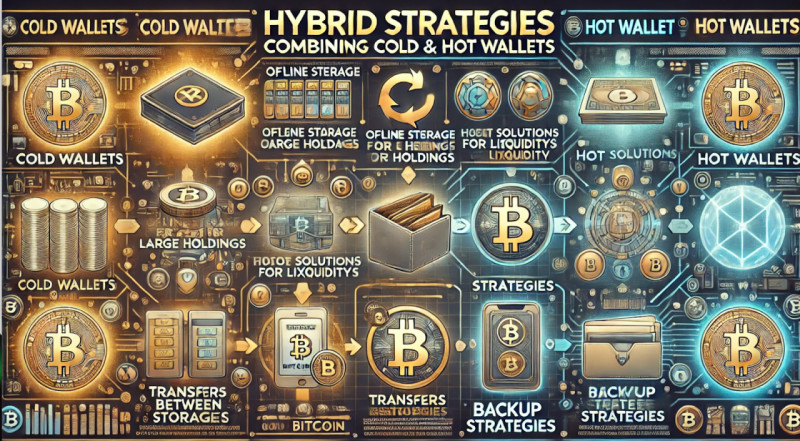
- Offline storage for large holdings: keep the majority of Bitcoin in offline storage. The unconnected setup ensures safety from online threats, securing assets which do not need to be used immediately.
- Hot solutions for liquidity: smaller amounts can be kept in a hot wallet to accomplish daily spending or trades. This setup provides flexibility for making transactions without exposing the majority of funds.
- Transfers between storages: hybrid strategy allows smooth transfers between cold and hot wallets as needed. If large transactions are made, temporarily funds can be moved to the hot wallet, returning unused balances to offline storage after completing the transaction.
Backup Strategies
Managing cold and hot wallets requires a solid backup plan to safeguard assets:
- Offline resilience: if a hot wallet is compromised, unconnected backups ensure access to critical funds.
- Multiple recovery locations: keep recovery phrases or backup keys in secure, separate locations to prevent simultaneous loss.
- Redundancy: use a mix of wallets along with backup methods to ensure recovery options remain available in any scenario.
Benefits of a Hybrid Approach
- Enhanced security: keeping most Bitcoin offline minimizes exposure to cyberattacks. Only funds that are used immediately face online risks.
- Improved flexibility: access funds quickly while safeguarding long-term investments.
- Reduced loss risk: keeping large holdings offline protects against breakdown even if a hot wallet is breached.
Conclusion
Choosing between a hot or cold wallet Bitcoin depends on your security requirements as well as transaction frequency. Unconnected wallets provide optimal long-term storage, while hot wallets excel at providing convenience for everyday use. Combining both creates an ideal balance, ensuring that Bitcoin remains safe yet accessible. By diversifying storage methods, users can secure large portfolios or manage frequent trades with confidence.
Risks, Challenges of Cold Wallets
Offline storages offer exceptional security for long-term digital asset storage but pose unique risks. Safeguarding holdings requires proactive measures to reduce these threats.
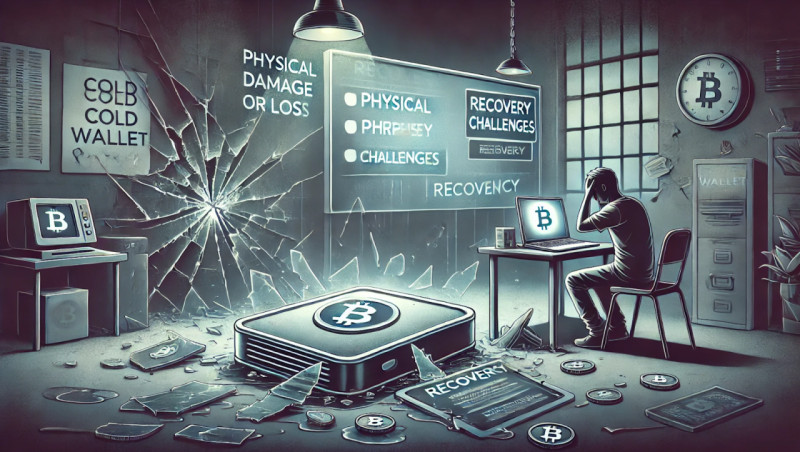
Physical Damage or Loss
Physical unconnected wallets, such as hardware devices or paper-based solutions, are susceptible to damage, theft, or misplacement. Hardware devices may break because of drops, fire, or water, while paper wallets can be torn, burned, or lost.
For risks minimization, apply these strategies:
- Fireproof safes: keep hardware or paper backups in fireproof safes to prevent damage from fires.
- Waterproof containers: use waterproof safes or cases to shield assets from flooding or spills.
- Secure locations: select safe, accessible locations like safety deposit boxes or private vaults to protect paper wallets.
- Diversify storage: keep backups in different, secure places — one at home, another in a different facility. This ensures you still have access if one location is compromised.
Focusing on physical security reduces the likelihood of losing or damaging backups beyond recovery.
Recovery Challenges
Without reaching recovery phrases or private keys, regaining control over Bitcoin or other assets is nearly impossible. Losing these details is a common as well as critical risk.
Securing recovery phrases:
- Multiple copies: always create several copies of recovery phrases, kept in various secure locations. Relying on a single copy may lead to irreversible loss.
- Trusted repositories: use safety deposit boxes or durable steel backups. Some choose vaults or specialized storage services.
- Avoid digital storage: never keep recovery phrases or private keys in digital formats (emails, cloud storage, screenshots). Digital records are vulnerable to hacking.
Planning for Emergencies
It's essential that trusted individuals can access your funds in emergencies.
- Emergency plan: include instructions to access backups, such as how to access a safe or retrieve assets.
- Nominate a successor: designate someone who knows where backups are kept and knows the retrieval process.
Testing recovery: ahead of fully trusting your unconnected wallet setup, simulate recovery to ensure the process works as intended.
Human Error
Despite best security practices, human mistakes remain a major risk. Simple errors like losing keys, sending funds to the wrong address, or using untrusted methods can result in substantial losses.
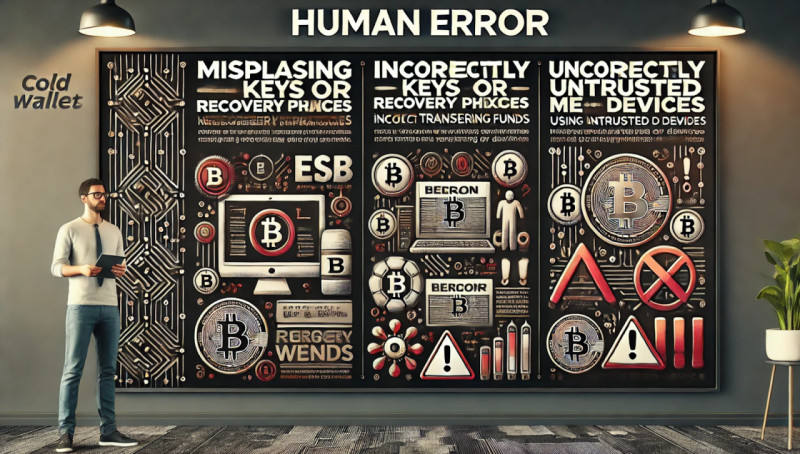
Misplacing Keys or Recovery Phrases
Losing track of recovery phrases or private keys can prevent access to funds. Here's how to minimize this risk:
- Organize backups: keep detailed records of where each backup is kept, ensuring they are labeled as well as easily found.
- Use trusted systems: keep keys in secure ways, such as encrypted USB drives or a numbered system. Avoid personal notebooks or unsecured locations.
Incorrectly Transferring Funds
Sending assets to an incorrect address can result in irreversible loss. Even a cold wallet Bitcoin carries this risk.
- Verify addresses: always double-check addresses ahead of confirming transfers. Most storages display the last few characters for easy verification.
- Use QR codes: rather than manually entering addresses, use QR codes to reduce errors.
Using Untrusted Methods or Devices
Be cautious when managing offline wallets with third-party devices or services, as they may be compromised.
- Avoid public networks: never manage storages over unsecured networks like public Wi-Fi. Stick to trusted, secure environments.
- Purchase devices from authorized sellers: Always buy hardware devices from trusted sources for avoiding counterfeit devices, which may contain malware designed to steal keys.
Conclusion
Unconnected wallets protect digital assets unsurpassed, but they require careful management. Risks like physical damage, loss of recovery phrases, human error can compromise security. By following best practices — such as securing physical backups, ensuring redundancy, avoiding mistakes — you can enhance the safety of your cold storage. Offline storage along with similar assets are long-term investments, with careful planning, you can ensure their security for years to come.
Top Cold Wallets in 2024
When securing Bitcoin, choosing an appropriate unconnected storage solution is crucial. The excellent options offer unmatched security, ease of use, reliability. This guide outlines leading cold storage choices to safeguard Bitcoin.
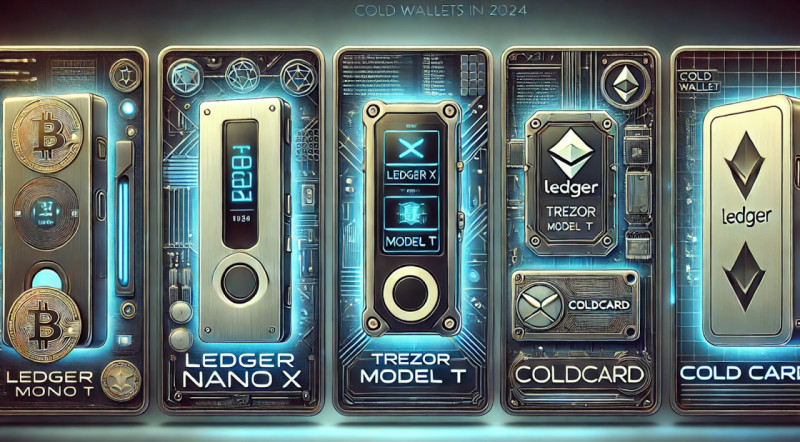
Hardware Devices
Hardware devices are considered the most secure offline method to hold Bitcoin. They keep private keys in encrypted, physical environments, protecting against online threats like malware or hacks.
Ledger Nano X. The Ledger Nano X, popular in 2024, supports numerous assets like Bitcoin, Ethereum, altcoins. Bluetooth enables wireless management via mobile app.
- Key features:
- Bluetooth: manage assets wirelessly with the mobile app.
- Multi-asset support: compatible with over 1,500 digital currencies.
- Enhanced security: equipped with a Secure Element (SE) chip to prevent tampering.
- Backup & recovery: recovery phrase helps restore assets if the device is lost or damaged.
- Pros:
- User-friendly, often preferred by beginners.
- Supports a wide range of assets.
- Reliable mobile integration via Bluetooth.
- Cons:
- Higher price than other models.
- Bluetooth may raise concerns for unconnected users.
Trezor Model T. Known for its touchscreen interface, Trezor Model T is secure, supports a variety of assets. Preferred by most users.
- Key features:
- Touchscreen interface: simplifies verification, address confirmation.
- Multi-Currency Support: Compatible with Bitcoin, Ethereum, ERC-20 tokens, etc.
- Advanced Security: Includes PIN, passphrase, two-factor authentication (2FA).
- Backup Options: Provides recovery seed, backup for restoring assets.
- Pros:
- High customization to enhance security.
- Open-source firmware increases transparency.
- Intuitive interface.
- Cons:
- Slightly pricier.
- No Bluetooth support.
Coldcard. Coldcard is designed to ensure maximum security, offering unconnected protection often chosen by privacy-conscious users.
- Key features:
- Offline operation: never connects online, ensuring complete offline transaction security.
- Advanced security: includes PIN protection, encryption, self-destruct feature after too many incorrect PIN attempts.
- MicroSD card support: offers unconnected backup options to keep keys, transaction data.
- Multisignature support: suits advanced users setting up multisig storages.
- Pros:
- Premium protection from online risks.
- Chosen by advanced users, multisig setups.
- Fully air-gapped for offline security.
- Cons:
- Doesn’t suit beginners.
- Less intuitive than other devices.
Trusted Paper Wallets
Paper wallets, another offline option, involve printing public and private keys. While secure unconnected, they are prone to physical damage as well as loss, requiring careful generation through trusted services to manage cold wallet Bitcoin.
BitAddress.org. BitAddress.org enables unconnected paper wallet creation, minimizing exposure to online threats.
- Key features:
- Offline Generation: Keys generated offline enhance security.
- Direct Printing: Clear instructions guide printing paper wallets.
- Customizable Addresses: Option for passphrase customization to add security.
- Pros:
- Simple, user-friendly interface.
- Full control over key generation.
- Entirely offline.
- Cons:
- Users must ensure secure printing.
- Vulnerable to theft or damage.
WalletGenerator.net. WalletGenerator.net allows secure unconnected paper wallet creation.
- Key features:
- Offline use: create storages offline by downloading the site’s code.
- Multi-currency support: supports Bitcoin, other digital currencies.
- Backup features: provides guidance on protecting paper backups.
- Pros:
- Easy process, highly secure.
- Cons:
- Requires some technical knowledge to be used offline.
- Vulnerable to physical risks like damage or theft.
Custom Offline Storage Solutions
For advanced users seeking tailored storage methods, custom options provide flexibility.
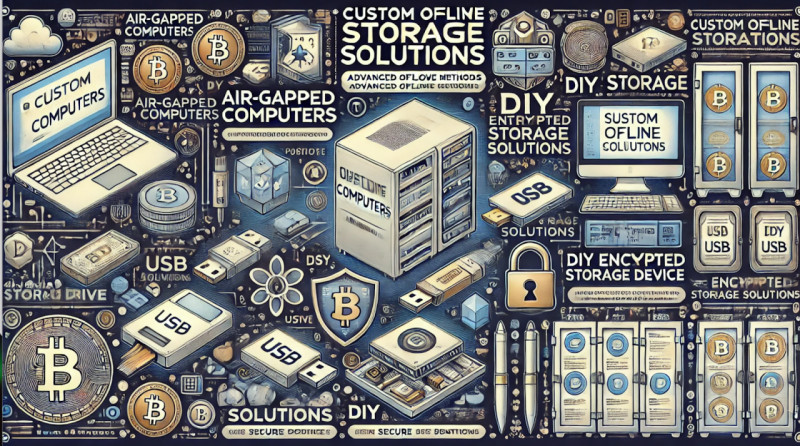
Air-gapped computers. Air-gapped computers are completely disconnected from the internet, ensuring secure private key management.
- Key features:
- Complete isolation: no online connection means no risk of external attacks.
- Total control: users manage key generation, backups privately.
- Enhanced privacy: chosen by those who prefer multisig setups as well as privacy-focused techniques.
- Pros:
- Ultimate offline security.
- Fully customizable.
- Cons:
- Requires technical expertise.
- Less convenient than hardware devices for everyday use.
DIY storage solutions. Some users build their own unconnected storage setups using custom hardware or software.
- Key Features:
- Complete customization: tailored to meet specific security needs.
- Open-source tools: DIY setups often use open-source software for flexibility.
- Pros:
- Highly adaptable, customizable.
- Full control over setup.
- Cons:
- Requires significant technical expertise.
- Increased risk if not properly implemented.
Conclusion
Choosing the right offline solution depends on your security needs, convenience, technical expertise. Hardware devices like Ledger Nano X, Trezor Model T, Coldcard offer excellent protection, while paper wallets along with air-gapped computers provide additional unconnected options. By selecting the best method, following best practices, you can ensure your Bitcoin remains safe from both online threats as well as physical risks.
The Future of Offline Storages
As digital assets become more widely accepted, safeguarding them securely is increasingly critical. Unconnected storage solutions — hardware devices along with offline methods — are evolving rapidly to meet rising demands for enhanced security as well as scalability. Below is an overview of trends shaping the future of unconnected crypto wallets.
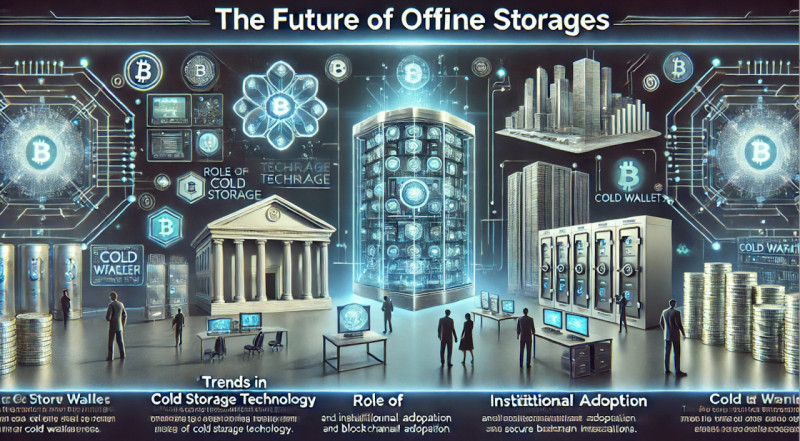
Trends in Cold Storage Technology
Offline storage technology advances quickly as developers address growing cyber threats, changing user needs. Innovations constantly reshape both the design as well as integration of unconnected storage within broader security frameworks.
Hardware device innovations
- Smarter devices: hardware wallets are becoming more intelligent, with enhanced user interfaces, stronger encryption, greater integration with mobile apps as well as desktop software. Future models will support more assets, offer accessible backups, enable seamless multi-device connectivity.
- Cross-platform integration: expect better integration between hardware devices and software ecosystems, simplifying asset management across multiple platforms. This will include built-in support for decentralized finance (DeFi) applications, multi-currency compatibility beyond Bitcoin.
- Biometric authentication: as manufacturers innovate, biometric verification — such as fingerprint scanning or facial recognition — may become a benchmark in managing cold wallet Bitcoin, combining something you know (PIN or passphrase), something you have (the device), something you are (biometric data).
Multi-signature solutions
- Enhanced security: multi-signature (multi-sig) solutions require multiple parties to approve a transaction ahead of its execution, adding layers of protection. As technology progresses, non-technical users will find it easier to implement, providing value for high-net-worth individuals or institutions seeking secure shared control of assets.
- Flexible configurations: future multi-sig solutions will allow users greater flexibility, such as requiring signatures from different devices or parties. This versatility will support everything from personal offline storage setups to institutional security systems.
Quantum-resistant encryption
- The threat of quantum computing: quantum computing, still in early stages, threatens traditional cryptographic systems. The encryption methods securing Bitcoin may eventually be broken by advanced quantum machines.
- Developing quantum-resistant methods: as quantum computing advances, quantum-resistant encryption will be crucial for unconnected storage solutions. Future cold wallets must integrate these new algorithms to safeguard digital assets from emerging threats.
Role of Cold Wallets in Institutional Adoption
Offline storage isn’t preferred just by individuals; large investors along with institutions are increasingly relying on unconnected methods to manage digital assets. As institutional adoption of digital currencies grows, cold wallets will become essential in securely managing large portfolios.
Institutional custodianship
- High-level security: Institutions like hedge funds, family offices, investment firms are turning to offline storage to protect large amounts of digital assets. These entities require premium security, often implementing multi-sig wallets, air-gapped systems, vaults in physical facilities.
- Third-party custodians: as institutional participation increases, third-party custodians offering unconnected wallet services are becoming more common. These services provide insured storage solutions, incorporating multi-sig technology, physical security, regulatory compliance to meet fiduciary standards.
Large-scale asset management
- Diversified storage approaches: large investors often adopt hybrid strategies, blending cold wallets with hot wallets for achieving liquidity. Some assets are kept offline, while others are kept on accessible platforms to accomplish active trading. This approach balances flexibility with protection from online risks.
- Global security standards: as the market matures, institutions are adopting standardized security protocols. Unconnected storage providers for institutional clients are incorporating advanced measures such as biometric access, physical barriers (e.g., bank vaults), real-time device monitoring to manage assets.
Regulatory compliance of cold storage
- Regulatory influence on security protocols: governments are increasingly establishing regulations on digital asset management. Offline storage solutions must comply with these standards, institutions managing large sums must follow strict rules on asset protection, transfer, auditing.
- Audit trails, transparency: institutional cold storages are evolving to include transparent audit trails as well as real-time transaction monitoring. This helps ensure compliance with anti-money laundering (AML), know-your-customer (KYC) regulations, allowing asset flows to be tracked without compromising security.
Conclusion
Offline solutions will continue evolving through technological advances, institutional adoption, rising security needs. Innovations in hardware devices, quantum-resistant encryption, professional custodianship will shape the cold wallet’s future.
As security remains paramount in the digital asset space, cold wallet Bitcoin will remain the most secure option for achieving long-term protection. Whether for individuals or institutions, they will provide a reliable way to safeguard Bitcoin while maintaining secure access.
Emerging technologies along with blockchain integration into finance will ensure that unconnected storages evolve alongside these changes, offering cutting-edge protection of Bitcoin, other digital assets as they become key components of the global financial system.
FAQs: Everything About Cold Storages
As more individuals seek long-term protection of Bitcoin as well as digital assets, questions about offline storages frequently arise. Whether you're new or experienced, knowing safe cold wallet use is essential. Here are answers to some common inquiries regarding unconnected cryptocurrency wallets.
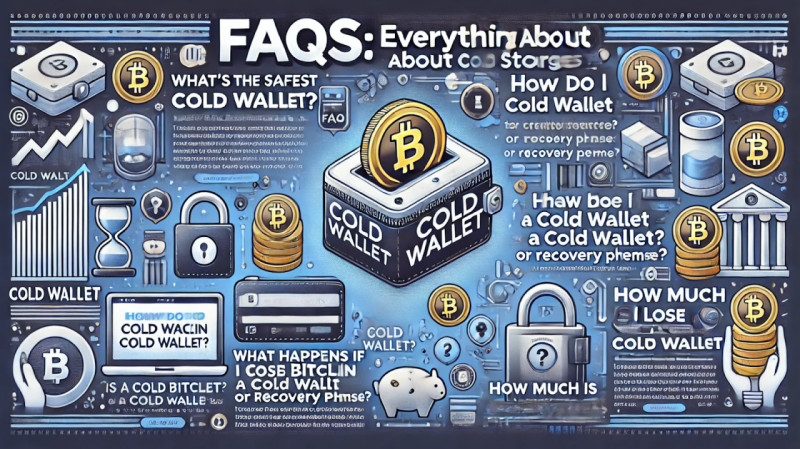
What’s the safest cold wallet?
Choosing the safest storage method depends on your needs as well as security preferences. Two commonly recommended offline storage types are hardware devices and advanced cold storage solutions.
Hardware devices
- Ledger Nano X: popular choice with robust security features, including a secure chip, Bluetooth support for mobile. Suits both beginners and experienced users.
- Trezor Model T: known for its touchscreen, open-source firmware, op-tier encryption.
- Coldcard: preferred by advanced users, providing top-notch security with offline signing along with a focus on privacy.
Advanced offline storage. For larger holdings, air-gapped computers or multi-signature solutions offer extra protection, but require advanced knowledge.
Bottom line: hardware devices like Ledger or Trezor offer sufficient security. Larger holdings or higher security needs might warrant air-gapped systems or multi-sig storages.
How do I transfer Bitcoin to a cold wallet?
Transferring Bitcoin to a cold wallet is simple but requires care.
Step-by-Step Guide:
- Set up your offline storage: follow the setup instructions carefully for hardware devices like Ledger or Trezor. Make sure the device is initialized, recovery phrases are securely recorded.
- Generate a receive address: use the storage’s interface to generate a receiving address.
- Initiate the transfer: from your exchange or platform, withdraw Bitcoin to the wallet's receive address. Double-check the accuracy of address.
- Confirm the transaction: use a blockchain explorer for keeping track of the transfer until it’s completed.
- Verify: once confirmed, check the storage balance to ensure the Bitcoin has been securely kept.
Are cold wallets completely hack-proof?
While offline storages offer far superior protection compared to hot wallets, they are not entirely immune to risks. Their unconnected nature prevents hackers from accessing them over the internet, but there are still vulnerabilities:
- Physical theft: if your wallet is stolen, an attacker could access your private keys or recovery phrase, compromising your assets.
- Human error: losing or misplacing your recovery phrase is a common vulnerability. Without proper backups, access to Bitcoin may be permanently lost.
- Compromised setup: if set up on an infected computer, malware could capture private keys or recovery phrases.
Bottom line: offline storages are highly secure but not invincible. Proper management practices, such as maintaining strong backups, securing devices, are crucial.
What happens if I lose my cold wallet or recovery phrase?
Losing either can result in permanent loss of access to your cold wallet Bitcoin. However, there are ways to minimize this risk:
- Recovery phrase: during setup, you’ll receive a recovery phrase (12–24 words). If the wallet is lost or damaged, use this phrase to restore Bitcoin to a new storage.
- Backup strategies: keep recovery phrases in multiple secure locations, never online, for avoiding hacker access.
- Redundancy: many choose keeping recovery phrases in safe deposit boxes, hidden safes, or other secure spots to add security in case of loss or theft.
Without a backup, Bitcoin becomes irretrievable. This underscores the importance of strong backup security.
How much does a cold wallet cost?
Offline wallet costs vary depending on the type as well as level of security.
Hardware wallets:
- Ledger Nano X: around $119 USD, with Bluetooth support as well as a secure chip.
- Trezor Model T: approximately $160 USD, offering enhanced security along with a touchscreen.
- Coldcard: about $120 USD, suits privacy-focused users with offline signing.
Paper wallets:
Creation is free, though printing materials, secure unconnected storage can incur additional costs.
Advanced cold storage solutions:
- DIY air-gapped computer: free if you have the necessary hardware as well as security software. However, dedicated setups can cost $200–$500+.
- Multi-signature solutions: typically low-cost for personal use, but can be higher for institutional setups.
Bottom line: offline storage costs range from free (paper wallets) to several hundred dollars (hardware devices or custom solutions). Institutional setups can be more expensive.
Unconnected wallets remain the safest method for long-term Bitcoin storage. By knowing risks, transfer processes, available options, you can ensure your assets are secure.
Conclusion: Secure Bitcoin with Cold Wallets
Protecting Bitcoin is crucial as digital assets rise in value as well as acceptance. The growing sophistication of threats demands robust safeguards. Cold storages, because of their offline nature, advanced security, remain one of the most reliable ways to shield Bitcoin from hacks, theft, other vulnerabilities. Knowing offline storage solutions is key to preserving your investment while maintaining control over assets for years.
Key Benefits of Cold Storage
Unconnected storage offers clear advantages over traditional online methods, with security being the most important. Since cold wallets are offline, they are immune to phishing, malware, or hacking. Without an internet connection, malicious actors can't access them remotely.
Another advantage is control. Offline storages ensure sole ownership of private keys — third parties cannot access your assets. Unlike exchanges or online platforms, which can be hacked or compromised, cold wallets guarantee self-sovereignty, meaning only you control access to Bitcoin.
Long-term preservation is another major reason to choose unconnected storage. Cold storages are preferred by those who wish to use Bitcoin in future or as a store of value without regularly accessing it. This makes offline storage preferred by those unconcerned with short-term market fluctuations.
Best Practices for Managing Bitcoin
Though unconnected storage offers excellent security, responsible management remains critical. Adhering to best practices significantly reduces risks.
- Backup recovery phrase: this phrase is crucial to regain access if your cold wallet Bitcoin is lost or damaged. Keep it in multiple secure locations, like a safe deposit box or fireproof safe. Avoid digital or online backups, which are vulnerable to hacking.
- Verify holdings regularly: periodically check your Bitcoin balance to ensure everything is in order, but do so without exposing private keys online. Many hardware devices allow balance viewing offline to add security.
- Physical security: unconnected storage security depends on its environment. Protect hardware or paper wallets from theft, water, fire damage by using fireproof, waterproof safes.
- Use multiple wallets: for enhancing protection, split holdings across multiple storages. If one wallet is compromised, you still have access to Bitcoin. In particular, keep some Bitcoin in a hardware device, the rest in a paper wallet.
Choosing the Right Offline Storage Solution
Selecting a cold storage depends on individual needs. For beginners or those with smaller amounts, hardware devices like Ledger or Trezor are user-friendly, portable, provide strong security. These are preferred by users protecting moderate Bitcoin amounts without complex setups.
Larger holdings or higher security requirements may call for multi-signature solutions or air-gapped computers. These methods require more technical expertise but offer an unmatched level of protection. Multi-signature wallets require several private keys for access, meaning a compromised key won't expose all assets.
For a low-cost, cold alternative, paper wallets are an option. While susceptible to physical damage or loss, paper wallets are easy to create, can be effective when proper precautions are taken.
Final Thoughts
Offline storages are crucial for anyone serious about Bitcoin security. The peace of mind knowing assets are offline, fully controlled, protected from online threats is priceless. Whether a seasoned investor or new to Bitcoin, incorporating unconnected storage into your security strategy ensures protection against evolving risks in the digital asset space.
By following best practices as well as choosing an unconnected storage solution that fits your needs, you can guarantee Bitcoin remains secure for the long term. Always remember: the security of your assets relies on the precautions you take. Act wisely, and your cold wallet Bitcoin will stay protected.





